 |
||
|
||
| ||
 This card wasn't expected much by enthusiasts who were looking forward to G800, but at that time Matrox was coming out of a bloody 3D race headed by NVIDIA and ATI. That is why the company just tried to do its best to save its niche of high-quality 2D OEM products. But just 2D is not enough today: one can often come across 3D sites and far not flat advertisements... That is why today 3D must be beautiful, high-quality, flawless, inexpensive. A total speed and fps are not of the most interest here, they must be just adequate to tasks implemented (of course, not gaming tasks, but business ones). So, today we have a business chip G550:
It's an excellent product for its niche: all in one. This simple and inexpensive card can boast of increased reliability and lowered prime cost. It works excellently with two monitors and is perfectly supported at the driver level. Besides, we have a good overlay hardware support. It's interesting that the card offers an integrated TV-out support, which won't make the card too complicated, but the cost of assemblage and testing will be reduced. Vertex shaders are improved, while pixel ones are too expensive to be realized in such chip. 2D quality of the primary RAMDAC is excellent. Now let me clarify the situation with the HeadCasting(TM) Engine. In standard vertex shaders supported by GeForce3 we can use up to 86 constant vectors when processing each vertex. For example, if we just multiply it by the set of matrices, we can use up to 96/4 (4 vectors for matrix), i.e. 24 matrices. It's more than enough for a great deal of game applications, but relatively more complex animations, such as animation of mimicry, may require a larger number of control points, and, therefore, matrices. T&L of the G550 allows making improved vertex shaders, which can use up to 256 constant vectors at the same time, i.e. up to 64 control matrices in the most primitive case. The shader's length was, therefore, increased from 128 to 256 instructions. Such hardware resources in the T&L allow simple programs, which use usual hardware matrix vertex blending, to use sets of matrices up to 64. Probably, G550 drivers just translate this DirectX call into the corresponding vertex shader created on the fly. Now let's look at this chip from a pessimistic point of view. It is the same G450, but with a T&L unit and two pixel pipelines. The card with 32 MBytes memory costs about $135. The G550's performance is much lower than other popular 3D solutions at the same price. It's lower than MX400 and a cheaper Radeon LE. On the other hand, we have a pressing ATI Radeon VE with two identical RAMDAC's (both working at 350 MHz) and more advanced video features (only $98). Well, Matrox may rely only on a firm 2D reputation, a doubtful advantage of vertex shaders with 256 constants and existing OEM contacts with powerful customers. That's all. But is it enough - not for taking the leading position, but just for maintaining its own niche generally and the company Matrox Graphics in particular? And now we will draw your attention right to the video card in question. CardThe Matrox Millennium G550 has AGP x2/x4 interface, 32 MBytes DDR SGRAM located in 2 chips on the right side of the PCB.   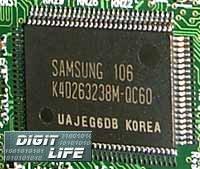 Samsung produces memory chips with 6 ns access time which corresponds to 166 (333) MHz. The memory works exactly at this frequency. But why there are only 2 chips? The reason is that today there are a lot of 32-bit high-volume modules (16 MBytes), and 2 such chips are enough for a 64-bit bus. A small-sized dark green PCB has a traditional black pinned heatsink without a cooler.  The most interesting peculiarity of the card is the way of mounting of the VGA connector for displaying a main signal on a primary monitor. 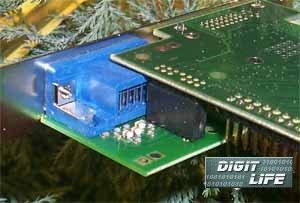 You may see that the connector is located on a daughter card which connects the main PCB. It resembles SIF from SUMA with its soapy images... 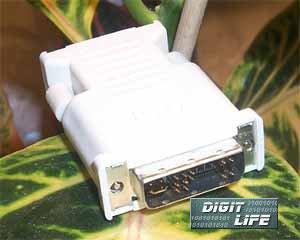 Matrox has turned to the typical of modern business cards form of providing a video card with an output for two receivers: the first output is standard VGA, the second is DVI, but together with the DVI-to-VGA adapter (on the right). Since the whole support of a digital interface is integrated into the main chip, it simplifies layout, making it cheaper. So, we can get an image on two receivers (for instance,
two monitors) using the DualHead technology which came from G400:
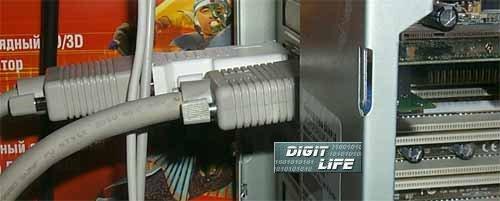
 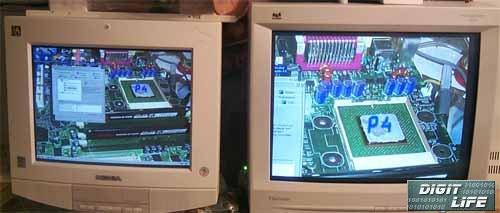 The 2 year old DualHead differs from the today's one in everything being integrated into one chip and in an increased frequency of the secondary RAMDAC. The TV-out is the same as of the G400.  The card is supplied with a traditional VGA-to-TV adapter so that we can display an image on a TV screen with the DVI-out. All above mentioned possibilities of the Matrox G550 are available not only in the Windows 9x line but also in the Windows 2000. Now some unique possibilities of the G550. First of all, it is Matrox Digimask. First you are to make two photos en face and half face:  With the special Digimask software  we get a 3D animated image which can be viewed with a special program.  This generated 3D image is very close to the original. Now comes the question whether all this is included into the hardware possibilities of the Matrox G550? The Matrox G550 serves only as a viewer. In order to get a final 3D image we need to convert the photos into a special format with the Digimask program, and the utility will send it to the Matrox's site. Some time later you will get a generated 3D image by e-mail. The Matrox G550 will help you improve the image with the HeadCasting making it smoother. So, we now understand that the G550 is just a redesigned G550 with the added Hardware TCL just for outward appearances; the product has become a bit cheaper because everything is integrated into the chip. The unique software can at the same time work on any other card (except HeadCasting). All those new things concerning 3D graphics make no sense to speak about as far as 3D games are concerned. However, this video card is aimed not at 3D games but at the business sector. Professionals who work much with 2D graphics in high resolutions like such cards very much. The card ships both in a Retail-package and in an OEM one. The box contains:
OverclockingAt present only the latest version of the PowerStrip 3.0 is able to define correctly an operating frequency of the G550. But even the PowerStrip sometimes displays 63 MHz of the core frequency :-) But when I tried to change the frequency figures jumped without any sense. That is why I couldn't understand how strong the card was overclocked. The performance has increased but it difficult to say what frequencies were set: the PowerStrip showed 166 MHz of the memory and 178 MHz of the core, but I don't believe the G550 can easily jump from 126 to 178 MHz. But the insignificant performance boost we obtained indicates that the memory's frequency dominates, like in case of the NVIDIA GeForce2 MX. And it was impossible to set other values. Installation and driversTest system configuration:
For tests we used drivers from Matrox Graphics v. 6.70, VSync was switched off (via the PowerStrip). For comparison analyses we used the following cards:
The drivers from Matrox include a proprietary program PowerDesk. 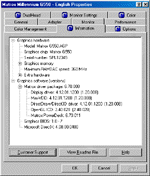 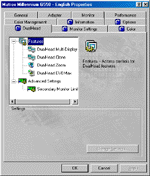 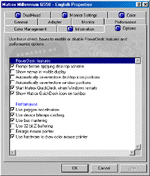 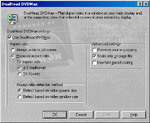 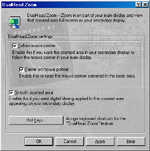 All settings are intended for controlling the card in 2D modes, the interface for activation of different DualHead modes is very convenient. 3D settings are just few, among which are Bus-Mastering and 32-bit Z-buffer. Well, it's all the same as in the G400. The PowerDesk utility has a pleasant design. Its icon is located in the task bar on the right:  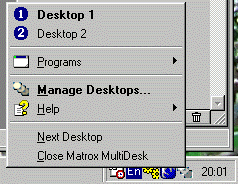 As you can see, the PowerDesk serves also for organization of virtual desktops. At present it's impossible to check functioning of the T&L unit of the card! The current drivers lack for even basic T&L possibilities not mentioning advanced vertex shaders and a record matrix blending and model skinning. The unit is locked either because of its incorrect functioning in this revision of the chip or because of unfinished drivers. Test resultsWell, installation of the VGA connector onto the daughter card is harmful for 2D quality. If earlier I always used Matrox G400 and G400 MAX as reference cards, the G550 performs worse. In 1600X1200 at 85 Hz the image is more soapy as compared with those cards. Of course, 2D may depend on a definite sample, but earlier I have never come across such cases. For estimation of 3D quality we used the following programs:
Quake3 Arenademo002, standard modesThe tests were carried out in two modes: Fast (16-bit color) and High Quality (32-bit color). 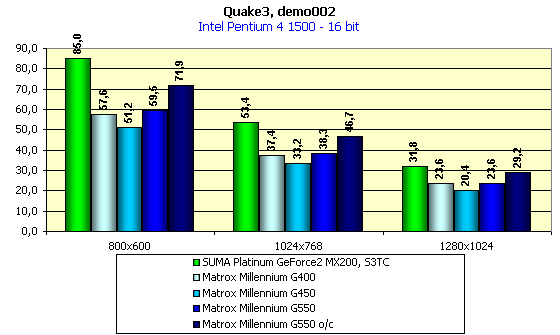 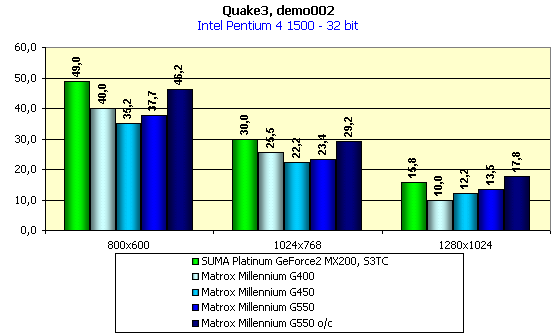 3DMark2001Game1, Low details 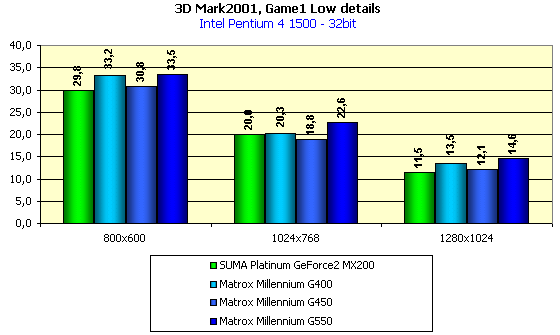 Game2, Low details  Game3, Low details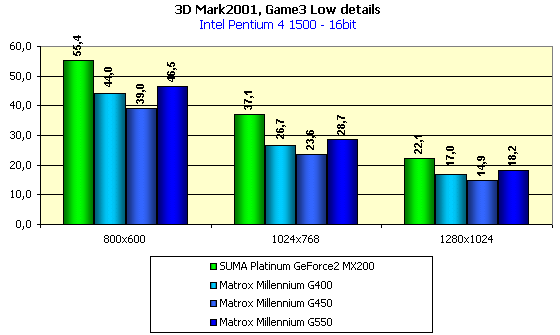  The situation is a bit better than in the Quake3; the Matrox Millennium G550 sometimes outscores the GeForce2 MX200 in 32-bit color. Nevertheless, the superiority is minimal, and the G550 can be referred to the MX200/TNT2Pro/G400 class. The Hardware T&L unit is so well hidden that no one program can see it. ConclusionThe Matrox Millennium G550 has a lot of advantages, but the number of drawbacks is much more. The card is not meant for the market of 3D accelerators, that's why it is useless for fans of 3D games. The goal of the release of the G550 is just to remind the users that Matrox still exists. The card is equipped with unique software which includes attractive but useless at such 3D speed functions. The only significant difference from the G400/G450 is presence of digital monitors support: the G550 has got DVI. The current drivers do not allow using any possibilities of the T&L unit, including vertex shaders. The complete characteristics of video cards of this and other classes can be find in our 3Digest (the Matrox Millennium G550 will appear in our August review). Highs:
Lows:
Write a comment below. No registration needed!
|
Platform · Video · Multimedia · Mobile · Other || About us & Privacy policy · Twitter · Facebook Copyright © Byrds Research & Publishing, Ltd., 1997–2011. All rights reserved. |